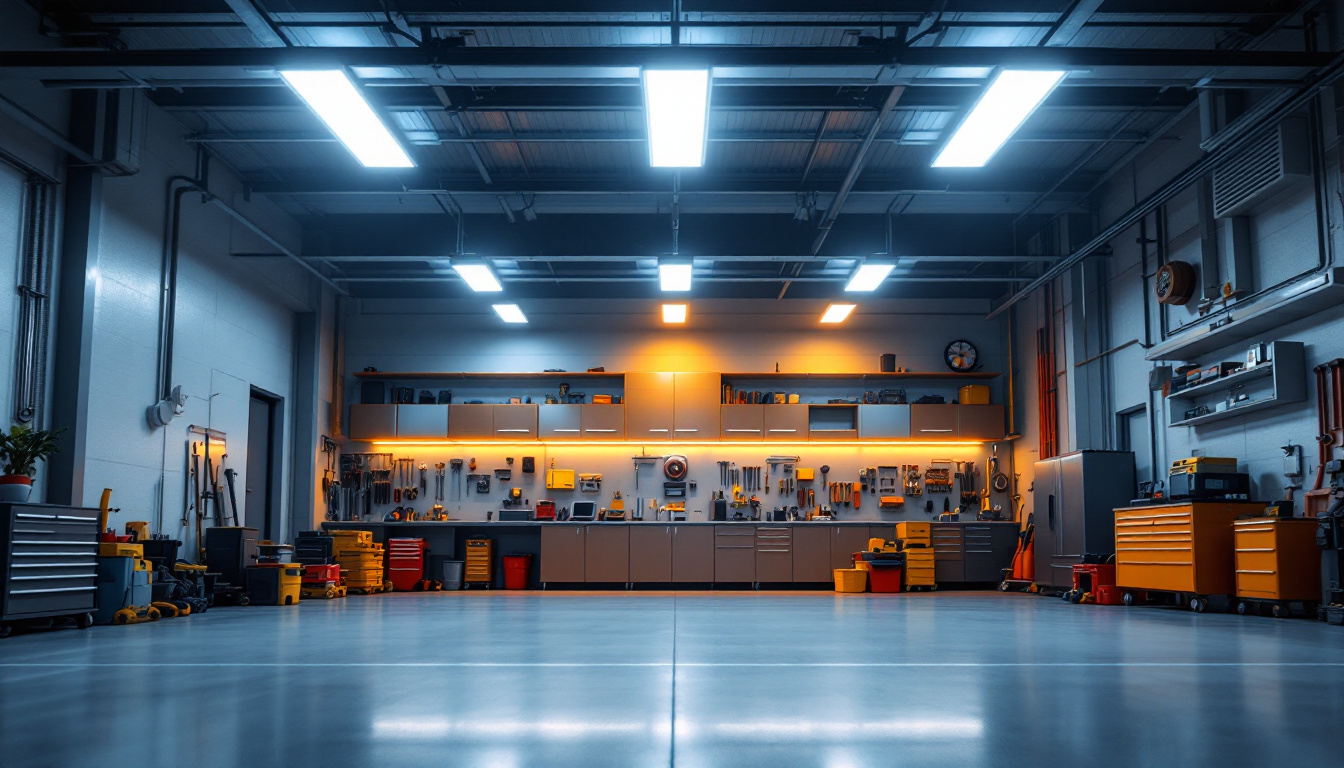
In the rapidly evolving world of lighting technology, LED lighting has emerged as a game-changer for both residential and commercial applications. For lighting contractors, understanding the nuances of LED technology is essential not only for providing superior service but also for staying competitive in the market. This article delves into critical insights that every lighting contractor should know about US LED lighting, covering everything from energy efficiency to installation techniques.
LED lighting has transformed the way we illuminate our spaces. With their energy efficiency and longevity, LEDs have quickly become the preferred choice for many applications. This shift has implications for contractors, who must adapt to new technologies and educate their clients on the benefits of LED solutions. As the market continues to evolve, staying ahead of trends in LED technology will be crucial for contractors looking to maintain a competitive edge.
One of the most significant advantages of LED lighting is its energy efficiency. LEDs consume up to 75% less energy than traditional incandescent bulbs, which translates into substantial cost savings for consumers. For contractors, emphasizing these savings can be a powerful selling point. By providing clients with a clear understanding of potential energy savings, contractors can help them make informed decisions that benefit both their wallets and the environment. Additionally, the reduced energy consumption contributes to lower carbon footprints, making LED lighting a more sustainable choice in the long run.
Moreover, many states and municipalities offer rebates and incentives for switching to LED lighting. Contractors should stay informed about these programs, as they can provide additional financial benefits to clients, making the transition to LED even more appealing. Furthermore, as energy prices continue to fluctuate, the stability of LED energy consumption can provide clients with predictable budgeting for their lighting needs, further enhancing the appeal of this technology.
LED lights boast an impressive lifespan, often exceeding 25,000 hours compared to just 1,000 hours for incandescent bulbs. This longevity not only reduces the frequency of replacements but also minimizes maintenance costs. For contractors, this means fewer service calls and a more satisfied customer base. The durability of LED fixtures also makes them ideal for a variety of environments, including commercial spaces, outdoor settings, and even harsh industrial applications where traditional lighting might fail more quickly.
Educating clients about the lifespan of LED fixtures can also help them appreciate the value of their investment. By highlighting the reduced maintenance and replacement costs, contractors can further solidify their position as trusted advisors in the lighting industry. Additionally, the advancements in LED technology have led to improvements in color rendering and dimming capabilities, allowing for greater customization in lighting design. This versatility not only enhances aesthetic appeal but also aligns with the growing trend of smart homes, where integrated lighting systems can be controlled remotely for added convenience and efficiency.
While the benefits of LED lighting are clear, the technology itself can be complex. Understanding the various components and specifications of LED products is crucial for contractors looking to provide the best solutions for their clients. With the rapid advancements in LED technology, staying updated on the latest innovations and trends can significantly impact project outcomes and client satisfaction.
Color temperature, measured in Kelvin (K), plays a vital role in the ambiance of a space. LEDs come in a range of color temperatures, from warm whites (around 2700K) to cool whites (up to 6500K). Contractors should be knowledgeable about these options to help clients choose the right lighting for their specific needs. For instance, warmer tones are often preferred in residential settings, creating a cozy atmosphere, while cooler tones are typically favored in commercial environments, promoting alertness and productivity.
Additionally, the Color Rendering Index (CRI) measures how accurately a light source displays colors compared to natural light. A higher CRI indicates better color accuracy, which is particularly important in settings like retail and art galleries. Understanding these metrics allows contractors to make informed recommendations that enhance the overall aesthetic and functionality of a space. For example, in a restaurant, the right color temperature and CRI can influence diners’ perceptions of food quality and ambiance, ultimately affecting their dining experience.
LED drivers are essential components that regulate the power supplied to LED fixtures. Understanding the different types of drivers, including constant current and constant voltage, is crucial for ensuring optimal performance. Contractors should be aware of the compatibility of drivers with various LED products to avoid issues during installation. Moreover, selecting the right driver can enhance energy efficiency and prolong the lifespan of the LED fixtures, which is a significant selling point for clients concerned about long-term costs.
Dimming capabilities are another important consideration. Not all LED products are dimmable, and those that are may require specific dimmers to function correctly. Educating clients about these options can enhance their experience and satisfaction with their lighting systems. Furthermore, the ability to adjust brightness levels can create dynamic environments, allowing spaces to transition from functional to ambient lighting seamlessly. This flexibility is particularly appealing in multi-use spaces, where different activities may require varying lighting conditions throughout the day.
Proper installation is key to maximizing the benefits of LED lighting. Contractors must adhere to best practices to ensure safety, efficiency, and longevity of the lighting systems they install.
When installing LED fixtures, it is crucial to ensure that the wiring is compatible with the new technology. Older wiring systems may not support the lower wattage of LED lights, leading to potential issues. Contractors should assess the existing electrical infrastructure before proceeding with installation to avoid complications.
Additionally, using the correct gauge of wire is essential for maintaining efficiency and safety. Contractors should always refer to manufacturer guidelines to ensure compliance and optimal performance. It is also advisable to use wiring that is rated for the specific environment in which the LEDs will be installed. For instance, outdoor installations may require weather-resistant wiring to withstand moisture and temperature fluctuations, while indoor installations may benefit from using low-voltage wiring to enhance safety and reduce energy consumption.
Heat management is another critical aspect of LED installation. While LEDs generate less heat than traditional bulbs, they still require proper ventilation to prevent overheating. Contractors should ensure that fixtures are installed in a manner that allows for adequate airflow, particularly in enclosed spaces.
Using heat sinks and ensuring proper placement can help mitigate heat-related issues, extending the lifespan of the fixtures and maintaining their performance. Furthermore, it is important to consider the ambient temperature of the installation site. High ambient temperatures can exacerbate heat buildup, so installing LEDs in cooler areas or providing additional cooling solutions, such as fans or vents, can significantly enhance their efficiency. Additionally, regular maintenance checks to clean dust and debris from fixtures can help maintain optimal airflow and prevent overheating, ensuring that the lighting system operates at peak performance for years to come.
As LED technology continues to evolve, so too do the regulations governing its use. Contractors must stay informed about local, state, and federal regulations that may impact their projects.
Many jurisdictions have implemented energy codes that require specific efficiency standards for lighting installations. Contractors should familiarize themselves with these codes to ensure compliance and avoid potential fines. Staying updated on changes to energy standards can also provide contractors with a competitive edge, as they can offer solutions that meet or exceed regulatory requirements.
In addition to energy efficiency regulations, safety standards play a crucial role in LED lighting installations. Contractors must ensure that all products used meet safety certifications, such as UL or ETL listings. These certifications indicate that the products have been tested for safety and performance, providing peace of mind for both contractors and clients.
Adhering to safety standards not only protects clients but also minimizes liability for contractors. Ensuring that all installations are compliant with safety regulations is a fundamental responsibility that should never be overlooked.
The landscape of LED lighting is constantly changing, driven by advancements in technology and shifting consumer preferences. Contractors must remain agile and adaptable to thrive in this dynamic environment.
One of the most significant trends in lighting technology is the rise of smart lighting systems. These systems allow users to control their lighting remotely, adjust brightness, and even change color temperatures through smartphone apps or voice-activated devices. Contractors should familiarize themselves with smart lighting solutions to meet the growing demand for these innovative products.
Integrating smart technology into lighting designs can enhance the user experience and provide added convenience. Contractors who can offer smart lighting solutions will position themselves as forward-thinking professionals in the industry.
As sustainability becomes increasingly important to consumers, contractors must be prepared to offer eco-friendly lighting solutions. This includes not only LED products but also sustainable practices in installation and disposal. Educating clients about the environmental benefits of LED lighting can further enhance their appeal.
Contractors can also explore partnerships with manufacturers that prioritize sustainability, ensuring that the products they offer align with eco-friendly values. This commitment to sustainability can differentiate contractors in a competitive market.
In conclusion, understanding the intricacies of US LED lighting is essential for lighting contractors looking to excel in their field. From the energy efficiency and longevity of LED products to installation best practices and regulatory considerations, a comprehensive knowledge of LED technology is crucial.
As the industry continues to evolve, staying informed about emerging trends such as smart lighting and sustainability will be vital for contractors seeking to remain competitive. By embracing these insights and adapting to the changing landscape, lighting contractors can provide exceptional service and value to their clients, ensuring a bright future in the world of LED lighting.
Ready to elevate your lighting game and deliver unmatched value to your clients? Look no further than LumenWholesale. Our commitment to providing contractors with the highest quality, spec-grade lighting products at wholesale prices ensures that you can tackle any project with confidence. Say goodbye to middleman markups and hello to a vast selection of reliable, high-performance lighting solutions that meet the strictest industry standards. Plus, with the convenience of free shipping on bulk orders, you can enjoy premium lighting at the best value — all without hidden fees or compromises. Don’t miss out on the perfect blend of quality, affordability, and convenience. Wholesale Lighting at the Best Value is just a click away with LumenWholesale.

Discover the essentials of wafer lighting in this insightful guide tailored for lighting contractors.

Discover the transformative journey of LED fluorescent garage-ready high-lumen bulbs and their impact on the lighting industry.

Discover essential best practices for using a 750 W power inverter tailored specifically for lighting contractors.

Discover how LED lights are transforming the landscape for lighting contractors by replacing traditional recessed lighting.